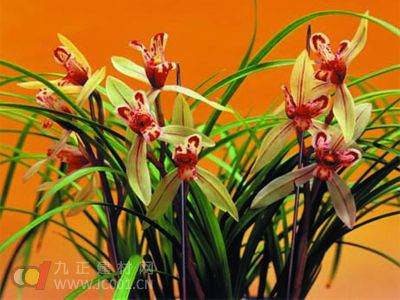Yunnan is home to a rich diversity of orchids, with many species thriving in its unique geographical and climatic conditions. Among them, the lotus petal orchid stands out as a notable variety. Cultivated using humus soil, this orchid has been grown for generations, particularly in western and northwestern Yunnan. The name "lotus petal" comes from the flower's resemblance to a lotus, and it is also known as "Small Selangor" among the Bai and Naxi people, while it is called "Bealand" in some parts of China.
The lotus petal orchid belongs to the genus Chunlan and is native to Yunnan. It features small pseudobulbs, linear leaves with serrated edges, and a distinct "V" shape at the base. Flowering occurs between December and March, with blooms in various colors such as red, yellow, light green, and white. The flowers are fragrant and have a striking appearance, making the lotus petal easy to identify.
Most lotus petal orchids grow on slopes between 1,500 and 2,500 meters above sea level, often under pine, eucalyptus, or shrub forests. They prefer loose, nutrient-rich humus soil that is slightly acidic, well-drained, and moist. Through years of experience, local growers have perfected techniques for cultivating these orchids using humus soil, which provides an ideal environment for their growth.

Humus soil is essential for successful cultivation. It should be rich in organic matter, well-aerated, and free from pathogens and pests. It can be divided into different types, such as rotted leaf soil, shrub humus soil, and pine needle soil. Among these, rotted leaf soil is considered the best for growing lotus petal orchids due to its balanced nutrients and structure.
Rotted leaf soil is widely used in Yunnan because it mimics the natural environment where orchids thrive. However, it may contain harmful bacteria or pests, so careful preparation is necessary. Before use, the soil should be tested for pH levels, ideally between 5.5 and 7.0. If the pH is too high or low, adjustments like adding lime or ferrous sulfate can help balance it.
Disinfection methods include sun exposure for several days, steaming at 100°C for over an hour, or using low-temperature treatments. Once disinfected, the soil is ready for planting. Watering is a crucial aspect of care. During dry periods, the pot can be submerged in water for 2–4 hours, and foliar sprays should be applied every 3–4 days to keep the leaves moist without wetting the buds.
In terms of fertilization, humus soil already provides sufficient nutrients, so additional fertilizers are usually unnecessary. However, if you want to enhance growth, a mild application of nitrogen, phosphorus, potassium, and trace elements can be used. Over-fertilizing should be avoided, as the orchid’s roots are sensitive and prone to damage.
Cultivating lotus petal orchids with humus soil requires patience and attention to detail. With proper care, these beautiful flowers can thrive and bring joy to any orchid enthusiast.
Plastic Film Faced Plywood With Hardwood Core
LINYI JIUHENG IMPORT AND EXPORT CO.,LTD , https://www.jiuhengwood.com